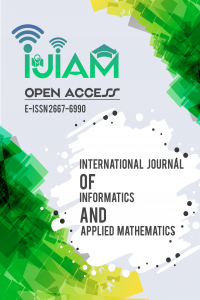Steganalysis of Chat Based Steganography
Steganalysis of Chat Based Steganography
Steganalysis, Chat, Timing Steganography,
___
- Nissar, A., & Mir, A. H. (2010). Classification of steganalysis techniques: A study. Digital Signal Processing, 20(6), 1758-1770.
- Johnson, N. F., & Jajodia, S. (1998, September). Steganalysis: The investigation of hidden information. In 1998 IEEE Information Technology Conference, Information Environment for the Future (Cat. No. 98EX228) (pp. 113-116). IEEE.
- Okello, M. O. (2022). Optimal Covert Communication Techniques. International Journal of Informatics and Applied Mathematics, 5 (1) , 1-26 . DOI: 10.53508/ijiam.1073205
- Kakungulu-Mayambala, R. (2008). Phone-tapping & the Right to Privacy: A Comparison of the Right to Privacy in Communication in Uganda & Canada. In BILETA Conference.
- Atuhaire, E. (2021). Artificial intelligence and the right to privacy in Uganda (Doctoral dissertation, Makerere University).
- Elsadig, Muawia & Gafar, Ahmed. (2022). PACKET LENGTH COVERT CHANNEL DETECTION: AN ENSEMBLE MACHINE LEARNING APPROACH. Journal of Theoretical and Applied Information Technology. 100. 7035-7043.
- Mivule, K., & Turner, C. (2012). Applying Data Privacy Techniques on Published Data in Uganda. In Proceedings of the International Conference on e-Learning, e-Business, Enterprise Information Systems, and e-Government (EEE) (p. 1). The Steering Committee of The World Congress in Computer Science, Computer Engineering and Applied Computing (WorldComp).
- Zhang, Y., Zhang, W., Chen, K., Liu, J., Liu, Y., & Yu, N. (2018, June). Adversarial examples against deep neural network based steganalysis. In Proceedings of the 6th ACM Workshop on information hiding and multimedia security (pp. 67-72).
- Tan, S., & Li, B. (2014, December). Stacked convolutional auto-encoders for steganalysis of digital images. In Signal and information processing association annual summit and conference (APSIPA), 2014 Asia-Pacific (pp. 1-4). IEEE.
- Tabares-Soto, Reinel, Raúl Ramos-Pollán, Gustavo Isaza, Simon Orozco-Arias, Mario Alejandro Bravo Ortíz, Harold Brayan Arteaga Arteaga, Alejandro Mora Rubio, and Jesus Alejandro Alzate Grisales. "Digital media steganalysis." In Digital Media Steganography, pp. 259-293. Academic Press, 2020.
- Gianvecchio, S., & Wang, H. (2007, October). Detecting covert timing channels: an entropy-based approach. In Proceedings of the 14th ACM conference on Computer and communications security. (pp. 307-316).
- Liu, G., Zhai, J., & Dai, Y. (2012). Network covert timing channel with distribution matching. Telecommunication Systems, 49(2), 199-205
- M. Okello, "A New Timing Steganography Algorithm in Real-Time Transmission Devices," 2018 IEEE 18th International Conference on Communication Technology (ICCT), Chongqing, China, 2018, pp. 880-884, doi: 10.1109/ICCT.2018.8600103.
- Okello, M. O. (2021). Transmission of Secret Information Based on Time Instances. The Eurasia Proceedings of Science Technology Engineering and Mathematics, 16, 209-218. DOI: 10.55549/epstem.1068612
- William Soukoreff, R., & Scott Mackenzie, I. (1995). Theoretical upper and lower bounds on typing speed using a stylus and a soft keyboard. Behaviour & Information Technology, 14(6), 370-379.
- Brysbaert, M. (2019). How many words do we read per minute? A review and meta-analysis of reading rate. Journal of memory and language, 109, 104047. Online blog typing speed by admin: https://onlinetyping.org/blog/average-typing-speed.php
- Başlangıç: 2018
- Yayıncı: International Society of Academicians
Study of Learner's Engagement in Online Learning Environments
Souhila ZERDOUDİ, Houda TADJER, Yacine LAFİFİ
Viability Control of Chemo-Immunotherapy and Radiotherapy by Set-Valued Analysis
Steganalysis of Chat Based Steganography
Recommendation of Pedagogical Resources Based on Learners’ Profiles
Safia BENDJEBAR, Nour El Islem DJEBARNİA, Zohra MEHENAOUİ, Yacine LAFİFİ
